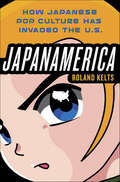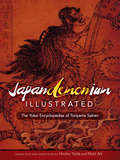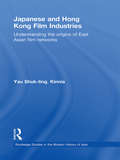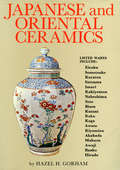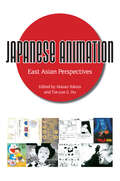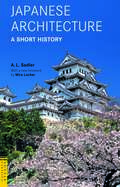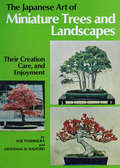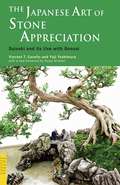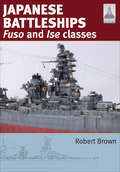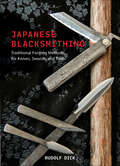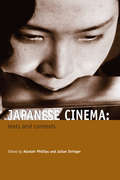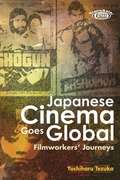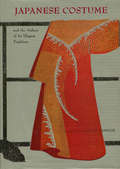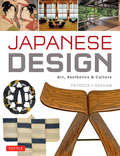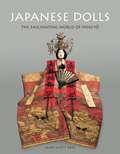- Table View
- List View
Japanamerica: How Japanese Pop Culture Has Invaded the U.S.
by Roland KeltsContemporary Japanese pop culture such as anime and manga (Japanese animation and comic books) is Asia's equivalent of the Harry Potter phenomenon--an overseas export that has taken America by storm. While Hollywood struggles to fill seats, Japanese anime releases are increasingly outpacing American movies in number and, more importantly, in the devotion they inspire in their fans. But just as Harry Potter is both "universal" and very English, anime is also deeply Japanese, making its popularity in the United States totally unexpected. Japanamerica is the first book that directly addresses the American experience with the Japanese pop phenomenon, covering everything from Hayao Miyazaki's epics, the burgeoning world of hentai, or violent pornographic anime, and Puffy Amiyumi, whose exploits are broadcast daily on the Cartoon Network, to literary novelist Haruki Murakami, and more. With insights from the artists, critics, readers and fans from both nations, this book is as literate as it is hip, highlighting the shared conflicts as American and Japanese pop cultures dramatically collide in the here and now.
Japandemonium Illustrated: The Yokai Encyclopedias of Toriyama Sekien
by Toriyama SekienFirst English publication of all four of Sekien's masterworks: The Illustrated Demons' Night Parade, More Illustrated Demons from Past and Present, Even More Demons from Past and Present, and An Idle Horde of Things.
Japanese American Resettlement through the Lens: Hikaru Iwasaki and the WRA's Photographic Section, 1943-1945
by Lane Ryo Hirabayashi Kenichiro ShimadaPhotographs by Hikaru C. IwasakiForeword by the Honorable Norman Y. Mineta In Japanese American Resettlement through the Lens, Lane Ryo Hirabayashi gathers a unique collection of photographs by War Relocation Authority photographer Hikaru Iwasaki, the only full-time WRA photographer from the period still living. With substantive focus on resettlement - and in particular Iwasaki's photos of Japanese Americans following their release from WRA camps from 1943 to 1945 - Hirabayashi explores the WRA's use of photography in its mission not only to encourage "loyal" Japanese Americans to return to society at large as quickly as possible but also to convince Euro-Americans this was safe and advantageous. Hirabayashi also assesses the relative success of the WRA project, as well as the multiple uses of the photographs over time, first by the WRA and then by students, scholars, and community members in the present day. Although the photos have been used to illustrate a number of publications, this book is the first sustained treatment addressing questions directly related to official WRA photographs. How and under what conditions were they taken? Where were they developed, selected, and stored? How were they used during the 1940s? What impact did they have during and following the war? By focusing on the WRA's Photographic Section, Japanese American Resettlement through the Lens makes a unique contribution to the body of literature on Japanese Americans during World War II.
Japanese American Resettlement Through the Lens
by Kenichiro Shimada Lane Ryo HirabayashiIn Japanese American Resettlement through the Lens, Lane Ryo Hirabayashi gathers a unique collection of photographs by War Relocation Authority photographer Hikaru Iwasaki, the only full-time WRA photographer from the period still living. With substantive focus on resettlement - and in particular Iwasaki's photos of Japanese Americans following their release from WRA camps from 1943 to 1945 - Hirabayashi explores the WRA's use of photography in its mission not only to encourage "loyal" Japanese Americans to return to society at large as quickly as possible but also to convince Euro-Americans this was safe and advantageous. Hirabayashi also assesses the relative success of the WRA project, as well as the multiple uses of the photographs over time, first by the WRA and then by students, scholars, and community members in the present day. Although the photos have been used to illustrate a number of publications, this book is the first sustained treatment addressing questions directly related to official WRA photographs. How and under what conditions were they taken? Where were they developed, selected, and stored? How were they used during the 1940s? What impact did they have during and following the war? By focusing on the WRA's Photographic Section, Japanese American Resettlement through the Lens makes a unique contribution to the body of literature on Japanese Americans during World War II.
Japanese and Hong Kong Film Industries: Understanding the Origins of East Asian Film Networks (Routledge Studies in the Modern History of Asia)
by Shuk-ting, Kinnia YauDrawing on first-hand materials collected from the Chinese and Japanese literature as well as interviews with more than twenty filmmakers and scholars Kinnia Shuk-ting Yau provides a solid historical account of the complex interactions between Japanese and Hong Kong film industries from the 1930s to 1970s. The author describes in detail how Japan’s efforts during the 1930s and 1940s to produce a "Greater East Asian cinema" led to many different kinds of collaborations between the filmmakers from China, Hong Kong and Japan, and how such development had laid the foundation for more exchanges between the cinemas in the post-war period. The period covered by the book is the least understood period of the East Asian film history. Filling the gaps surrounding one of the most important but least understood periods of Asian film history this books discusses facts and resources once obscured by controversial issues related to wartime affairs with new insights and perspectives. This book is an invaluable source of information for understanding how the current East Asian film networks came into existence by looking beyond conventional single-case studies and adopting a transnational perspective in tracing the connections between different film industries.
Japanese and Oriental Ceramics
by Hazel H. GorhanJapanese and Oriental Ceramics was first published in print form by Tuttle Publishing in 1971.This comprehensive and profusely illustrated work tells how to distinguish Japanese porcelains from Chinese, and how to recognize modern reproductions of genuine old wares. It is completely indexed, contains a lengthy bibliography, and lists Chinese dates important in any discussion of Oriental ceramics.Crammed with information on the history, esthetics, and technical aspects of the ceramics of Japan and the Orient, the book is an invaluable guide to scholars, collectors and dealers. It is in fact a work of art in itself.
Japanese Animal and Floral Crest Designs (Dover Pictorial Archive)
by Paul NegriSoaring birds and scuttling crabs, preening peacocks, luxuriant blossoms, and winged dragons -- this invaluable treasury abounds in exotic motifs. Drawn from traditional Japanese family crests, these 1,160 black-and-white patterns, symbols, and decorative devices span a tremendous variety of styles, from utter simplicity to florid majesty.Designers, crafters, and hobbyists will find this easy-to-use volume a practical companion. Whether as a convenient collection of unusual and striking graphics, or as a starting point for design inspiration, this compilation assures users of a constant source of timeless beauty.
Japanese Animation: East Asian Perspectives
by Masao Yokota and Tze-yue G. HuJapanese Animation: East Asian Perspectives makes available for the first time to English readership a selection of viewpoints from media practitioners, designers, educators, and scholars working in the East Asian Pacific. This collection not only engages a multidisciplinary approach in understanding the subject of Japanese animation but also shows ways to research, teach, and more fully explore this multidimensional world. Presented in six sections, the translated essays cross-reference each other. The collection adopts a wide range of critical, historical, practical, and experimental approaches. This variety provides a creative and fascinating edge for both specialist and nonspecialist readers. Contributors' works share a common relevance, interest, and involvement despite their regional considerations and the different modes of analysis demonstrated. They form a composite of teaching and research ideas on Japanese animation.
Japanese Architecture: A Short History
by A. L. Sadler Mira LocherA. L. Sadler's invaluable study of Japanese architecture first appeared in 1941. Considered a classic in its field, unequaled in clarity and insight, Japanese Architecture A Short History is a lucid and uncomplicated introduction to this important aspect of Japanese culture. Beginning with the earliest evidences from prehistory and ending with the Edo period, when Japan attained stature as a modern state, Japanese Architecture is as relevant today as it was in 1941.
The Japanese Art of Minature Trees and Landscapes
by Giovanna M. Halford Yuji YoshimuraNOW AT LAST an eminently practical book about one of Japan's most fascinating arts. Japanese miniature landscapes and, particularly, dwarf trees-"bonsai," as they are frequently called even in the West-have long been admired throughout the world, and large sums have been spent importing them into other countries, often only to have them die. There is something so magical, unearthly even, about their gemlike beauty that their creation has generally been thought an occult science, and for the layman even their care and preservation have seemed to be shrouded in mystery. As this book proves, however, the creation and care of bonsai is a comparatively simple art which can actually be systematically taught rather than, as in earlier books on the subject, just talked about vaguely. Now, given a reasonably green thumb and a modicum of patience, anyonein any country can create his own bonsai; and still easier is it to apply the few matter-of-fact rules necessary to keep a finished bonsai in healthy and vigorous condition for generations. Here are detailed instructions, together with many helpful diagrams and charts and a treasury of photographs, on every phase of the art: propagation and training, with hints for those in a hurry and for small-apartment dwellers; daily and seasonal care, and treatment of pests; how to judge, select, and exhibit bonsai, with emphasis always upon the untold enjoyment they can provide. Included also, for those who want still more detailed information, are invaluable appendices concerning tools and equipment, soil analyses, and precise data on the more than three hundred species of plants used in making bonsai. This, then, is a definitive work, one which has long beenneeded and which will remain the bonsai book for years to come. It is a book for those who want to try their hand at a fascinating hobby; for those who, preferring to buy their bonsai ready-made, want to fulfill their responsibility of preserving such miniature loveliness; and for those who want simply to understand more about one of Japan's most treasured traditions, "sculpturing beauty in living wood."
The Japanese Art of Stone Appreciation: Suiseki and its Use with Bonsai (Tuttle Classics)
by Sonja Arntzen Vincent T. Covello Yuji YoshimuraThe Japanese Art of Stone Appreciation is an exploration into the art of suiseki--small, naturally formed stones selected for their shape, balance, simplicity and tranquility.<P><P>Written by two leading experts in the field of Japanese gardening and art, this concise introduction offers aesthetic guidance and direct practical advice that is a window into traditional Japanese culture. It details the essential characteristics of a high-quality suiseki, describing the various systems of stone classification in this Japanese art form and explaining how to display a suiseki to its best advantage. There is also a section on incorporating suiseki alongside a bonsai tree, the most popular and rewarding complement to peaceful suiseki miniature landscape gardens.Sections include:Historical BackgroundCharacteristics and Aesthetic QualitiesClassification of SuisekiDisplaying a StoneSuiseki with Bonsai and Other Related ArtsCollecting SuisekiHow to Make a Carved Wooden BaseSuiseki Classification Systems
Japanese Battleships: Fuso & Ise Classes (ShipCraft #24)
by Robert BrownThis fully illustrated guide offers historical context and step-by-step instruction for building and modifying Japanese battleship models. This volume in the ShipCraft series covers the two related classes of Japanese 14in-gunned battleships, originally built during the First World War but subsequently reconstructed. These ships are famous for their towering forward superstructure, usually described as a pagoda bridge, that they featured when rebuilt. The Ise-class ships underwent further reconstruction during the Second World War to emerge as a unique hybrid of battleship and aircraft carrier to compensate for fleet carriers sunk earlier in the war. This lavishly illustrated guide takes readers through a brief history of the Fuso-class and Ise-class ships, highlighting differences between sisterships and changes in their appearance over their careers. It features color profiles of paint schemes as well as detailed line drawings and scale plans. The modelling section reviews the strengths and weaknesses of available kits, lists commercial accessory sets for super-detailing, and provides hints on modifying and improving the basic kit. This volume also includes a photographic survey of selected high-quality models in a variety of scales and a section on further research references
Japanese Blacksmithing: Traditional Forging Methods for Knives, Swords, and Tools
by Rudolf DickDiscover the blacksmithing techniques used to make 10 traditional Japanese objects with insights from the artisans and rare glimpses inside their workshops. The art of blacksmithing and steel processing didn't reach Japan until more than 1,000 years after it was developed in the Western world. It is therefore all the more astonishing to see the high culture of forging that developed in the Land of the Rising Sun within a short period of time. This comprehensive reference book explains the traditional methods used by Japanese tool-, knife-, and swordsmiths and gives the reader a rare and unique look inside their workshops. In these pages, readers will find • forging methods and techniques for 10 special products—hammer, chisel, axe, hatchet, gardener's machete, sickle, fish knife, folding knife, straight razor, and Japanese sword; • more than 150 color photographs that illustrate and explain the techniques used to create classic Japanese forged pieces; • chapters on Japan's oldest coppersmithing facility and traditional tatara steel smelting; and • helpful tables that detail the materials, chemistry, elements, and temperatures needed to harden, form, and manipulate the metal being forged. This is a must-have book, not only for amateur and professional smiths, but also for all admirers of Japanese craft culture.
Japanese Castles AD 250-1540
by Stephen TurnbullDr Stephen Turnbull is internationally recognised for his research into and writing on Japanese military history. Here he applies his scholarship to an account of the evolution of Japanese defensive architecture and engineering, from early earthworks through to wooden and earth castles and, finally, the emergence of the stone towers that are so characteristic of the samurai. He also plots the adaptation of Japanese castles to accommodate the introduction of firearms. With unpublished photographs from the author's private collection and full-colour artwork, including detailed cutaways, this is an essential guide to the fascinating development of Japanese castles.
Japanese Cinema: Texts and Contexts (Critical Concepts In Media And Cultural Studies)
by Alastair Phillips Julian StringerJapanese Cinema includes twenty-four chapters on key films of Japanese cinema, from the silent era to the present day, providing a comprehensive introduction to Japanese cinema history and Japanese culture and society. Studying a range of important films, from Late Spring, Seven Samurai and In the Realm of the Senses to Godzilla, Hana-Bi and Ring, the collection includes discussion of all the major directors of Japanese cinema including Ozu, Mizoguchi, Kurosawa, Oshima, Suzuki, Kitano and Miyazaki. Each chapter discusses the film in relation to aesthetic, industrial or critical issues and ends with a complete filmography for each director. The book also includes a full glossary of terms and a comprehensive bibliography of readings on Japanese cinema. Bringing together leading international scholars and showcasing pioneering new research, this book is essential reading for all students and general readers interested in one of the world’s most important film industries.
Japanese Cinema Goes Global
by Yoshiharu TezukaJapan's film industry has gone through dramatic changes in recent decades, as international consumer forces and transnational talent have brought unprecedented engagement with global trends. With careful research and also unique first-person observations drawn from years of working within the international industry of Japanese film, the author aims to examine how different generations of Japanese filmmakers engaged and interacted with the structural opportunities and limitations posed by external forces, and how their subjectivity has been shaped by their transnational experiences and has changed as a result. Having been through the globalization of the last part of the twentieth century, are Japanese themselves and overseas consumers of Japanese culture really becoming more cosmopolitan? If so, what does it mean for Japan's national culture and the traditional sense of national belonging among Japanese people?
Japanese Costume: And the Makers of Its Elegant Tradition
by Shojiro Nomura Helen Benton MinnichWith dozens of photographs and expertly written text, this Japanese clothing book is the authoritative guide on the kimono.<P><P>Japanese Costume invites the reader to explore the world of Japan's textile arts and costume decoration-from its origins in legendary times, through its brilliant development in the intervening centuries, to its emergence into the modern era. The book which is the first in English to present the full sweep of Japanese achievement in the costume arts, is essential the story of the kimono and its evolution.The text is accompanied by a generous selection of fine illustrations and photographs: 54 in full color, 119 in black and white, and 12 line drawings. They include not only pictures from contemporary sources-such as the picture scrolls and woodblock prints- but also photographs of kimono masterpieces and representative textiles.
Japanese Design
by Patricia J. GrahamWhat exactly is the singular attraction of Japanese design? And why does it speak so clearly to so many people all over the world? The Japanese sensibility often possesses an intuitive, emotional appeal, whether it's a silk kimono, a carefully raked garden path, an architectural marvel, a teapot, or a contemporary work of art. This allure has come to permeate the entire culture of Japan-it is manifest in the most mundane utensil and snack food packaging, as well as in Japanese architecture, and fine art. In Japanese Design, Asian art expert and author Patricia J. Graham explains how this aesthetic based in fine craftsmanship and simplicity developed. Her unusual, full-color presentation reveals the Japanese design aesthetic in an absorbing way, using a combination of insightful explanations and more than 160 stunning photos. Focusing upon ten elements of Japanese design, Graham explores how visual qualities, the cultural parameters and the Japanese religious traditions of Buddhism and Shinto have impacted the appearance of its arts. Japanese Design is a handbook for the millions of us who have felt the special allure of Japanese culture, crafts, and art. Art and design fans and professionals have been clamoring for this-a book that fills the need for an intelligent, culture-rich overview of what Japanese design is and means.
Japanese Design
by Patricia J. GrahamWhat exactly is the singular attraction of Japanese design? And why does it speak so clearly to so many people all over the world? The Japanese sensibility often possesses an intuitive, emotional appeal, whether it's a silk kimono, a carefully raked garden path, an architectural marvel, a teapot, or a contemporary work of art. This allure has come to permeate the entire culture of Japan-it is manifest in the most mundane utensil and snack food packaging, as well as in Japanese architecture, and fine art.In Japanese Design, Asian art expert and author Patricia J. Graham explains how this aesthetic based in fine craftsmanship and simplicity developed. Her unusual, full-color presentation reveals the Japanese design aesthetic in an absorbing way, using a combination of insightful explanations and more than 160 stunning photos. Focusing upon ten elements of Japanese design, Graham explores how visual qualities, the cultural parameters and the Japanese religious traditions of Buddhism and Shinto have impacted the appearance of its arts.Japanese Design is a handbook for the millions of us who have felt the special allure of Japanese culture, crafts, and art. Art and design fans and professionals have been clamoring for this-a book that fills the need for an intelligent, culture-rich overview of what Japanese design is and means.
Japanese Design
by Patricia J. GrahamWhat exactly is the singular attraction of Japanese design? And why does it speak so clearly to so many people all over the world? The Japanese sensibility often possesses an intuitive, emotional appeal, whether it's a silk kimono, a carefully raked garden path, an architectural marvel, a teapot, or a contemporary work of art. This allure has come to permeate the entire culture of Japan-it is manifest in the most mundane utensil and snack food packaging, as well as in Japanese architecture, and fine art. In Japanese Design, Asian art expert and author Patricia J. Graham explains how this aesthetic based in fine craftsmanship and simplicity developed. Her unusual, full-color presentation reveals the Japanese design aesthetic in an absorbing way, using a combination of insightful explanations and more than 160 stunning photos. Focusing upon ten elements of Japanese design, Graham explores how visual qualities, the cultural parameters and the Japanese religious traditions of Buddhism and Shinto have impacted the appearance of its arts. Japanese Design is a handbook for the millions of us who have felt the special allure of Japanese culture, crafts, and art. Art and design fans and professionals have been clamoring for this-a book that fills the need for an intelligent, culture-rich overview of what Japanese design is and means.
Japanese Design
by Patricia J. GrahamWhat exactly is the singular attraction of Japanese design? And why does it speak so clearly to so many people all over the world? The Japanese sensibility often possesses an intuitive, emotional appeal, whether it's a silk kimono, a carefully raked garden path, an architectural marvel, a teapot, or a contemporary work of art. This allure has come to permeate the entire culture of Japan-it is manifest in the most mundane utensil and snack food packaging, as well as in Japanese architecture, and fine art.In Japanese Design, Asian art expert and author Patricia J. Graham explains how this aesthetic based in fine craftsmanship and simplicity developed. Her unusual, full-color presentation reveals the Japanese design aesthetic in an absorbing way, using a combination of insightful explanations and more than 160 stunning photos. Focusing upon ten elements of Japanese design, Graham explores how visual qualities, the cultural parameters and the Japanese religious traditions of Buddhism and Shinto have impacted the appearance of its arts.Japanese Design is a handbook for the millions of us who have felt the special allure of Japanese culture, crafts, and art. Art and design fans and professionals have been clamoring for this-a book that fills the need for an intelligent, culture-rich overview of what Japanese design is and means.
Japanese Design Motifs: 4,260 Illustrations of Japanese Crests (Dover Pictorial Archive)
by Matsuya CompanyThis collection presents more than 4,000 individual designs in the 900-year-old tradition of Japanese family crests. Through constant variation and invention over the centuries, this has become one of the richest graphic art traditions in the world.Most of these motifs are circular, and they can all be fitted into a square. Within those limitations is a seemingly endless range of designs, beginning with the dozens and dozens of root motifs — rice plant, gingko, scallop, lightning, anchor, spool, raft, candle, scissors, fern, saki bottle, lotus blossom, mountain arrow, pine, wisteria, ship, rabbit, and scores of others. Practically every kind of plant, bird, animal, natural phenomenon, and manufactured object of Japanese culture was at one time or another included in a family crest. In addition, each of the root designs was treated to dozens of imaginative variations — they were reproduced bilaterally, in triangles, diamonds, five- and six-pointed stars, in spirals, were built up in series, made to overlap, combined with each other, and so on. Some of these are classic and recognizable designs, like the yin-yang, linked rings, and treasure knot. Many of the others have rarely been seen in the West.Graphic artists, textile designers, pattern-makers, advertisers, and other commercial artists looking for an untapped source of novel, appealing designs will find a wealth of material here. Some of these motifs can be used to suggest an exotic flavor, and others are universal and can be used almost anywhere.
Japanese Dolls
by Alan Scott PateFor the art enthusiast, the doll collector, as well as the casual reader, the world of Japanese dolls is a fascinating one. For centuries, Japanese doll artisans created spectacular works of art, invested with both significant cultural meaning and elemental beauty, encased in the deceptively simple body of a doll.In Japanese Dolls: The Fascinating World of Ningyo, Alan Scott Pate, the leading American expert on Japanese dolls, answers the many and varied questions surrounding how to collect these amazing artifacts. What types of dolls are available for the collector of today? What are some of the features and characteristics that will help collectors identify the dolls they find and evaluate them? Who were some of the earliest collectors in Japan, Europe and the United States? How do we preserve and care for these invaluable artifacts from Japan's past? Focusing on the 18 most widely collected, obtainable and affordable antique and vintage Japanese dolls, this book is a cornucopia of information for collectors of all levels and interests.
Japanese Dolls
by Alan Scott PateFor the art enthusiast, the doll collector, as well as the casual reader, the world of Japanese dolls is a fascinating one. For centuries, Japanese doll artisans created spectacular works of art, invested with both significant cultural meaning and elemental beauty, encased in the deceptively simple body of a doll.In Japanese Dolls: The Fascinating World of Ningyo, Alan Scott Pate, the leading American expert on Japanese dolls, answers the many and varied questions surrounding how to collect these amazing artifacts. What types of dolls are available for the collector of today? What are some of the features and characteristics that will help collectors identify the dolls they find and evaluate them? Who were some of the earliest collectors in Japan, Europe and the United States? How do we preserve and care for these invaluable artifacts from Japan's past? Focusing on the 18 most widely collected, obtainable and affordable antique and vintage Japanese dolls, this book is a cornucopia of information for collectors of all levels and interests.
Japanese Environmental Design and Management for Sustainable Urbanism: Learning from Satoyama (Planning, Heritage and Sustainability)
by Takashi ArigaThis book responds to the need to rehabilitate the holistic urban environment by introducing planning approaches which focus on the Japanese idea of “Satoyama.”“Sustainable development” has become a prime concern of planning, and society is expending great efforts to achieving this end. Appreciation of cities’ environmental assets has become more widely accepted and deeply taken to heart—not only by specialists, but also by citizens and communities. The balance between human settlements and the natural environment has changed. This has posed an environmental issue in that urban settlements engulf the greenbelts and water networks that help sustain the urban natural environment. Given these issues, we must consider a morphology toward creating a more sustainable urban system that regenerates the relationship between human settlements, utilizing the architectural resources within our urban fabric and its interaction with the surrounding natural environments. This book is a guide to the theory, methodologies and practical applications of environmental design and city and regional planning of regenerative systems toward sustainable urbanism. This book also explores the socio-cultural and economic implications of sustainable urbanism and examines urban forms, land use patterns and their built-up environments that can result from the applications.This book will appeal to a wide range of readers including researchers and students of architectural design, urban planning, heritage protection and sustainable development, but also professionals who are involved in improving the relationship of human settlements with natural resources.
